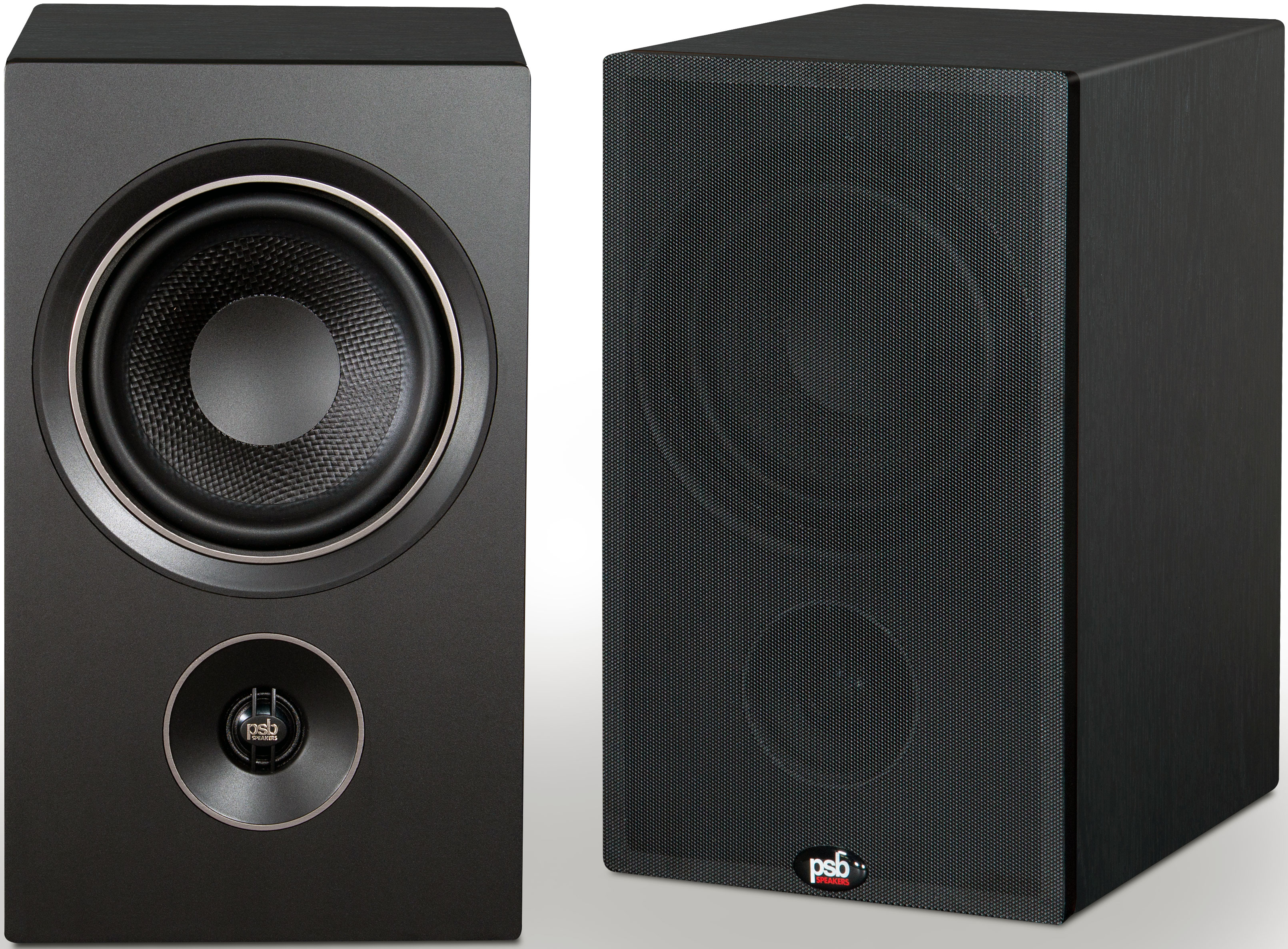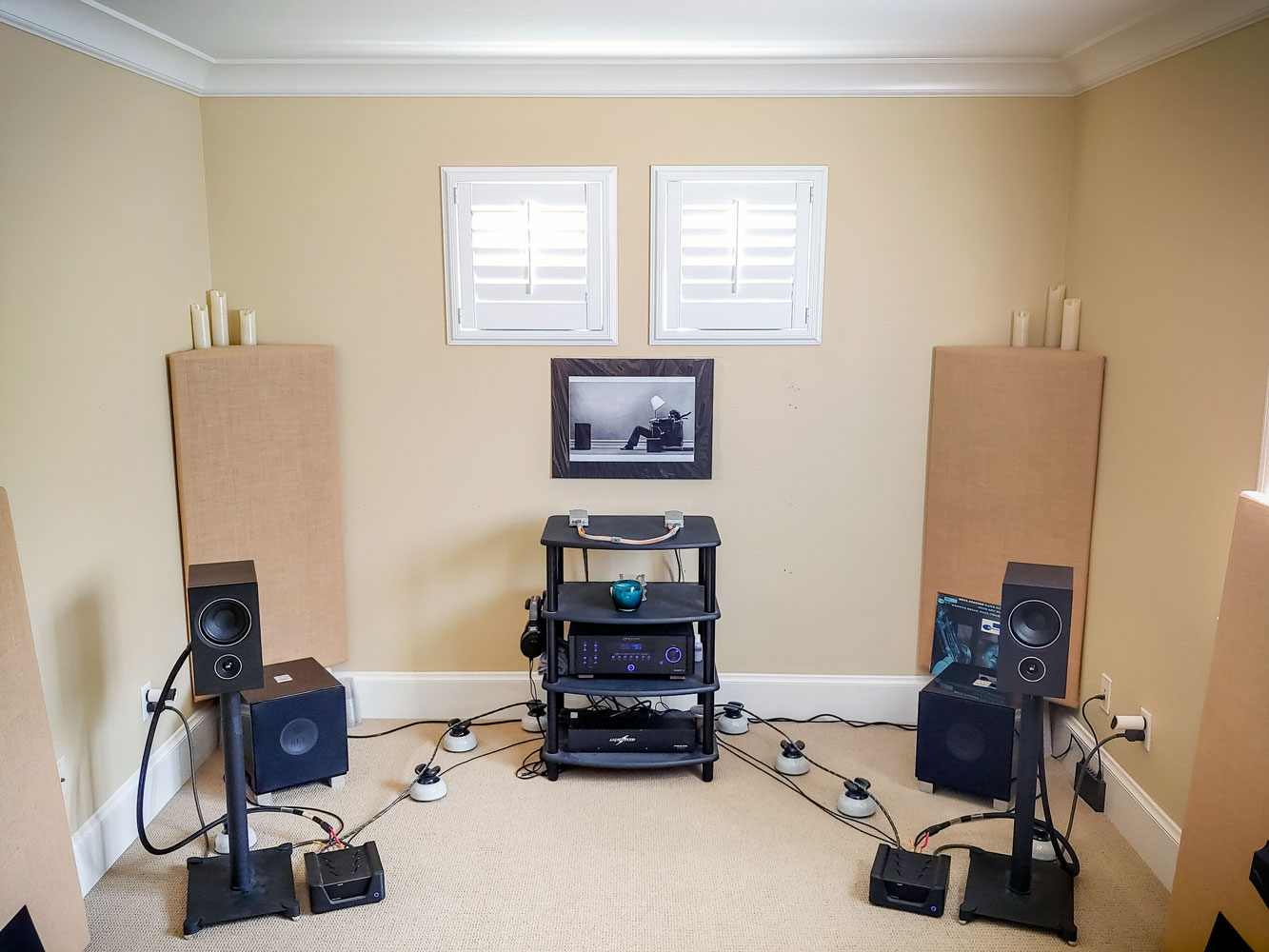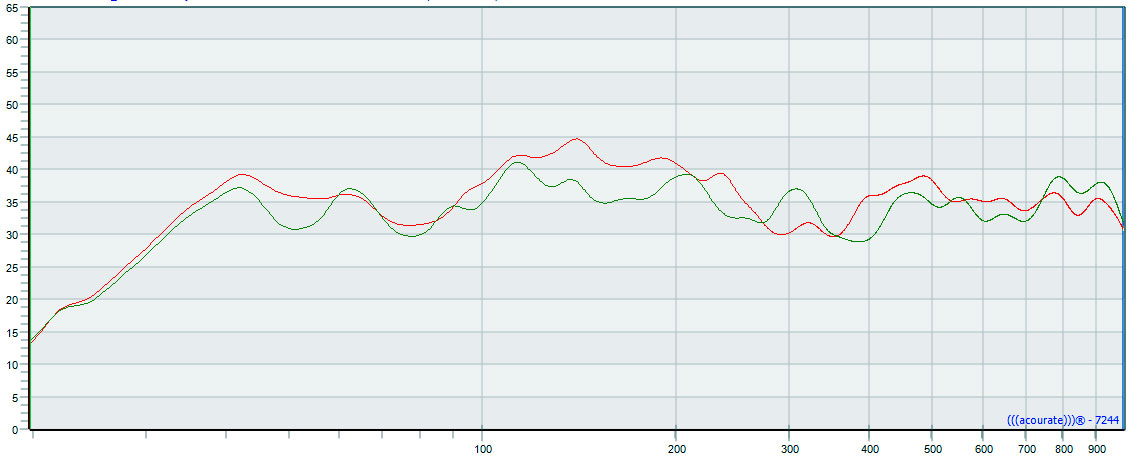The PSB Alpha P5 Bookshelf Speaker
The P5 sits in the middle of the new Alpha series, a 5.25-inch 2-way bookshelf speaker flanked by the 4.5-inch 2-way P3 bookshelf and dual 5.25-inch woofer T20 tower. For home theater applications, a matching C10 center channel speaker is also available. All of the new Alphas pair custom designed bass drivers with the same .75-inch black anodized aluminum dome tweeter to deliver consistent sound and high-frequency dispersion across the line while optimizing the presentation of mids and bass for each enclosure type.
Smooth off-axis response and, as with the original Alpha, performance over features remains the priority here. However, the new line does sport decent quality 5-way binding posts, removable magnetic grills, and 4th order Linkwitz-Riley crossovers. Adjusted for inflation, the new P5 cost less than the original Alphas did at launch in 1991, and in spite of having a slightly smaller bass driver, they outperform the original in every measurable and perceivable category.
P5 Unpacking and Product Description
The P5 arrive as a pair, well packed in an unassuming but sturdy cardboard box. There are no fancy felt bags or included cables, but everything is wrapped securely and protected from moisture and rough handling during shipping. My review samples were clad in a black ash wrap with nice texture and smooth edges. There is a faint seam down the center of the bottom of each enclosure where the edges of the wrap join, but apart from that, fit and finish are excellent for a $349 pair of loudspeakers. Both drivers are trimmed with attractive slightly off-silver accent rings, and the PSB logo is fitted to the tweeter’s phase shield. Markings on the speakers reinforce the designer’s intention that they are to be deployed with the woofer on top. Around the back, there’s a threaded hole for attaching a wall-mount bracket and a bass reflex port just above a single pair of 5-way binding posts.
The roughly 10-pound enclosures are deep, nearly 50% deeper than they are wide. This gives them a tidy, compact appearance from the front while maintaining sufficient internal volume to make decent bass. Anechoic response is rated -3 dB at 55 Hz; however, in my 15.5-feet long, 10-feet wide dedicated listening room I heard and measured useful bass output down to at least 30 Hz with no audible chuffing from the rear ports. That’s incredible output from a pair of 5.25-inch woofers!
P5 Setup Recommendations
Because the P5 was designed specifically to exhibit well-behaved off-axis response, it will work well in a wide variety of rooms. However, I found that attention to detail during setup was more rewarding than usual for speakers near this price point. I placed them on 26-inch tall stands with the front-center of the speakers just under 5 feet from the rear walls and about 20 inches from the sidewalls. This put the P5’s just under 7 feet apart on center with my listening position about 8 feet away and exactly equidistant to each tweeter.
If your room is like mine and necessitates placing the speakers within three feet of the side walls, definitely consider treating first reflection points with absorption or diffusion. Without treatment, the difference in arrival time between the reflections and direct sound will be so close that the brain will attempt to integrate them, resulting in an awkward mix of the two that smears the soundstage. When placed precisely, the P5’s perform a lovely disappearing act that’s a delight to experience. The “upside down” placement has to do with the direction of lobing from the 4th-order Linkwitz-Riley crossovers. With the woofer above the tweeter, this tilts upwards towards seated and standing listening positions. Invert the speakers, and they will neither look nor sound right.
Exact placement in your room will almost certainly differ from mine; most listeners won’t be able to keep them so far from the rear wall without intruding upon their décor. That’s fine, but definitely try to maintain at least a foot or two of space behind them since they are rear ported. Experiment with the location of your listening position and the distance between the speakers, always being sure to keep an identical distance between each speaker and your ears. Accurate stereo soundstage presentation depends on subtle timing queues that are muddied or lost when one speaker is closer to the listening position than the other.
Measurements
Unlike others, I don’t attempt to take anechoic, quasi-anechoic, or close-miked measurements in an attempt to verify manufacturer’s claims about speaker performance. While the data might be interesting to some readers, I honestly don’t have the equipment or time to do these properly, and this data is rarely helpful for understanding how a product will sound in my room. Instead, measuring the response of different speakers in my room and from my listening position is helpful to confirm what I’m hearing.
The plot above was created with the mic exactly 8 feet from each tweeter and about 3.5 feet from the rear wall of my 15.5 feet x 10 feet listening room. This is as close to the position of each of my ears as I can get with a single calibrated microphone. The range of this sweep was from 20 Hz to 1 kHz, since I’m mostly interested in seeing bass interaction with the room relative to transition into the midrange. As you can see, with room-gain, there is substantial output at 40 Hz and useful output down to 30 Hz. Roll-off is a smooth 20 dB/octave.
Anomalies and differences between the left and right channels are consistent with measurements I’ve taken of other similarly placed loudspeakers and are indicative of room modes, not deficiencies in the P5’s design. With DSP, I can achieve a perceptually flat response +1/-3 dB from 37 Hz to 20 kHz, but our brains are remarkably capable of adapting to these variations in in-room response as long as on-axis and response of the diffuse field are not fighting with each other. This is the hallmark of the P5 and Paul’s design, and while it may not be clear from my crude plots, it’s clearly audible in the room!
- ← Previous page
- (Page 2 of 4)
- Next page →





Thank you for a fine, interesting and fairly comprehensive review.
Many points of interest arose in viewing your setup. The room and equipment treatments are of particular interest.
I see you follow REL’s recommendation for corner placement of the subs. It’s gratifying to see you confirm that methodology. And, that you’re obviously a fan of the iFi AC purifiers.
What brand of bass traps are those? If I might be so bold, have you tried placing the subs on inexpensive granite tile slabs, which in turn rest on carpet spikes? Reportedly that will provide a tightening of bass.
Perhaps in future article(s) you could offer a few words in connection with ancillary accessories that you have found of value that do not require a dedicated music room?
I for one am looking forward to future articles on mini-Monitors, as I’m strongly considering the Dynaudio Emit M10 speakers. My Rega Brio (2017) Integrated Amp just died on me and in response I’m upgrading my amplification, which in turn is prompting me to upgrade from my Wharfedale 80th Anniversary ‘Denton’ speakers. (fine midrange, good bass but a bit ‘reticent’ in the treble… a bit too ‘relaxed’ is my assessment).
Hi Geoffrey,
Thanks for your kind words and for expressing an interest in the system context for this review. As you have observed, I have taken a rather pragmatic approach to system assembly and room tuning vs. “cost is no object.” I do appreciate REL’s ethos regarding not only placement but also electrical connection–feeding them signal from the same amplification channels that drive the main speakers. Both seem to support integration uniquely and effectively.
The bass traps and panels are from ATS Acoustics. Without them, the room has an RT60 of over 600 ms (pretty terrible). With treatment from ATS, RT60 is under 300 ms at the listening position. The QRD diffusers on the ceiling are from GIK Acoustics.
I have not tried spiked platforms under the subs; however, I have the crossovers set quite low. The presence of the T7i’s in the system is primarily to add a pinch of sub-bass pressurization rather than to augment bass output from the main speakers. I suspect that a platform and spikes might be more relevant if I were to cross them over higher. Thanks for the suggestion since it could be relevant when evaluating less capable monitors with these subs. Note: The RELs were powered off for most of my listening with the PSB Alpha P5!
Within more “lifestyle” listening spaces, the challenge is getting the environment quite enough to appreciate the subtle improvements to dynamics and resolution that most audio accessories are intended to deliver. The “Acoustic Art Panels” and “Acoustic Coffee Bag Panels” from ATS Acoustics may be an effective way to reduce the blurring effect of reflections while not spoiling décor. ATS also offers free online room acoustics analysis which can be helpful to estimate how many panels are required to effectively treat even a shared living space.
You make a good point that we pair loudspeakers to the room and amplification to the loudspeakers. The Denton 80’s should serve you very well and certainly look great. Enjoy!
— David